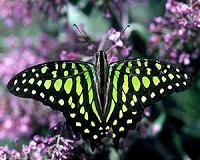| . |  |
. |
Hong Kong (AFP) May 6, 2011 Wild monkeys don't seem to care that Hong Kong is a concrete jungle -- they thrive so well on its fringes that the government has introduced birth control to curb a population boom. Easy food handouts from some of the city's seven million humans helped push macaque numbers to more than 2,000 in recent years -- and a rise in nuisance complaints about monkeys that have lost a natural fear of people. "I think we still have plenty of space for wildlife. But the countryside and the city are adjacent to each other and sometimes there is conflict," said Chung-tong Shek of the government's conservation department. Reports of aggressive monkeys chasing hikers for food, grabbing bags and reaching for pockets surfaced in recent years as the macaque population grew. Stray monkeys with an acquired taste for human food still occasionally run about the crowded shopping districts of the city. In April, one found its way to central Kowloon, near a strip of camera shops, hotels and fashion boutiques known locally as the Golden Mile. "There is plenty of food inside the city in the garbage. Some of them get lost in the city...from time to time," Shek told AFP. A decade-old feeding ban with the threat of a maximum HKD10,000 ($1,287) fine hardly dented the volumes of food on offer from well-wishers and tourists. So the government turned to birth control. Early field tests were carried out in 2002, in the world's first contraceptive programme targeting a citywide population of macaques, using methods including vasectomies on males and temporary injections on females. Now the programme focuses on the sterilisation of females, which is done about twice a month, bringing the total of monkeys permanently or temporarily neutered to more than 1,500. The first problem was catching the monkeys. All the monkeys are on the Kowloon peninsula especially around Kam Shan and Lion Rock country parks, with some outlying groups on the northwestern side of the territory. "It's very hard for people to catch a monkey. We tried everything," said Sally Kong, a spokeswoman for the conservation department. Net-guns, cage traps, live decoys, snares and dart guns were all used. But most methods could only be used a few times before the animals got wise to them. Before long, monkeys even learned to recognise individual conservation department staff members and their vehicles, and avoided them all together. Now large, baited cages are left open for days at a time, supplied by human feeders known and trusted by the monkeys. "That way when we trap them in there they don't panic. They just keep on eating as they've been in there many times before," said Paolo Martelli, chief veterinarian with the Ocean Park Conservation Foundation, which is contracted to carry out the sterilisations. "What we do is remove the tubes. Between the uterus and the ovaries there are small tubes that we cut out in very precise keyhole surgery. We go in, remove two pieces of tube and come out. It takes a few minutes," Martelli said. "It's beneficial to maintain their ovaries intact because of the very important hormonal role they play," he explained. Experts working on the project say the contraception plan is not about eliminating the macaques but is a conservation measure that makes it possible for the wild animals to continue existing on the city boundaries. The programme has received backing from independent animal rights groups. "Contraceptives are so much better than poisonings or other lethal methods that cause animals so much suffering," said Ashley Fruno, spokeswoman for People for the Ethical Treatment of Animals in the Asia-Pacific region. "This is another great example of non-lethal methods used to control wildlife populations." The monkeys seen today in Hong Kong are believed to be the descendants of a few rhesus macaques released early last century to eat poisonous plants around a newly built reservoir supplying drinking water for the city. The Strychnos plants are poisonous to humans but a favourite food for macaques, the conservation department says. There isn't a specific target number for the city's wild monkey population, Shek told AFP, but nuisance calls have dropped from a peak of 1,400 in 2006 to less than 200 in the last couple of years. "It really depends on what people can tolerate. Sometimes sighting a monkey is the reason for a person to call. This would be recorded as a nuisance complaint even if the monkey hasn't done anything," said Karthi Martelli, project manager with the Ocean Park conservation group. "I always tell people: mind your monkey manners. When you're scared you do stupid things and people blame the monkeys. If you ignore the monkey and walk away they get bored too. They don't plot to attack," she said.
Share This Article With Planet Earth
Related Links Darwin Today At TerraDaily.com
 'Barcoding blitz' on Australian moths and butterflies
'Barcoding blitz' on Australian moths and butterfliesCanberra, Australia (SPX) May 06, 2011 In just 10 weeks a team of Canadian researchers has succeeded in 'barcoding' 28,000 moth and butterfly specimens - or about 65 per cent of Australia's 10,000 known species - held at CSIRO's Australian National Insect Collection (ANIC) in Canberra. Conducted in collaboration with the Atlas of Living Australia (ALA) as part of the International Barcode of Life (IBoL), the project involved ex ... read more |
|
| The content herein, unless otherwise known to be public domain, are Copyright 1995-2010 - SpaceDaily. AFP and UPI Wire Stories are copyright Agence France-Presse and United Press International. ESA Portal Reports are copyright European Space Agency. All NASA sourced material is public domain. Additional copyrights may apply in whole or part to other bona fide parties. Advertising does not imply endorsement,agreement or approval of any opinions, statements or information provided by SpaceDaily on any Web page published or hosted by SpaceDaily. Privacy Statement |